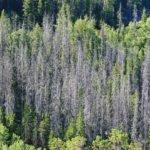Mountain Pine Beetles in decline, but Douglas-Fir Beetles could thrive after summer fires
Posted: January 22, 2018Source: Helena Independent Record by: Holly Michels

“When trees get fire-scorched they may not die, but they become susceptible to bark beetles,” Amy Gannon, forest pest management program manager with the Department of Natural Resources and Conservation, told the state Land Board last week.
Of particular concern is the Douglas-fir beetle, which can establish itself and thrive in burned trees, then build up large enough populations to take over healthier forests.
“After the fires, we anticipate quite a bit of mortality. Trust land foresters are already preparing for this,” Gannon said.
Montana has seen what Gannon called “a tremendous mountain pine beetle outbreak” in recent years, with some annual aerial surveys counting a million acres of new beetle-killed trees each year. Trees typically take a year to turn red after being killed by beetles, so there’s a lag between an infestation and observation of dead trees.
This year, Gannon told the Land Board that preliminary reports from aerial surveys show much smaller infestation levels.
For mountain pine beetles, surveys detected about 37,000 new infested acres, “which is quite insignificant,” Gannon said.
Most of that was in the Big Hole Valley. In previous years, up to a million new acres were discovered annually. During the peak of the infestation, more than 6 million acres were affected.
“Generally speaking, (with) mountain pine beetle, I can say that we’re over the outbreak,” Gannon said.
Douglas-fir beetle-infested acres were also down to about 37,000 new acres observed, but that could change after the fires.
“This one is also down at background levels,” Gannon said. “Although I am concerned about Douglas-fir beetles because it is closely linked with fire activity, and fire-scorched trees can really breed a lot of Douglas-fir beetles. Douglas-fir beetle is not on the rise right now, but we may see it again soon.”
Douglas-fir beetles inhabit burned and dead trees, building up their population. Once they reach large enough numbers, they spread to seemingly healthy trees. This happened after the fires in the summer of 2000 in the Bitterroot, when a tremendous uptick in Douglas-fir beetles was observed.
“We’re preparing for that now,” Gannon said. “And it may not happen, but it’s good to be prepared in case it does.”
With Douglas-fir beetles, Gannon said state trust lands managers look for scorched trees that can be marked for table sales so beetle populations don’t build up. Foresters can also trap Douglas-fir beetles.
“We’re expecting a lot more mortality,” Gannon said. “You guys have already talked about salvage sales, just from salvaging fire-killed trees, a lot of times after the fire.”
In “two to three years, we’ll see a lot of mortality from these other insects… Usually when there’s an issue, trust lands foresters will actively go in and harvest or thin or do what they need to do to make sure beetles don’t become an issue. They can respond fairly quickly,” he said.
Foresters can also use a pheromone that can prevent beetle attacks.
In eastern Montana, the pine engraver can take off in burned trees. Removing burned trees can help there, too, and traps can be used to pull beetles out of infested stands.
Private landowners are encouraged to get in touch with the DNRC or a consulting forester.
Drop in new observed acres
Gannon attributed the overall beetle decline in Montana to insect dynamics and lack of appropriate conditions for beetles to thrive.
Insects cycle through peaks, she said, and require a certain density of trees and climate conditions. Montana was warm and dry enough for beetles to get going and there was an expansive source of trees.
Mountain pine beetles specifically thrived in Montana because there was an uninterrupted landscape of lodgepole pine between 80-120 years old, Gannon said.
Douglas-fir beetles are less aggressive and need trees that are a bit weaker because of fire, age or overstocking.
“That’s why we’re concerned that we’re going to see a lot of activity with Douglas-fir beetles because a lot of trees were scorched by fires,” Gannon said.
